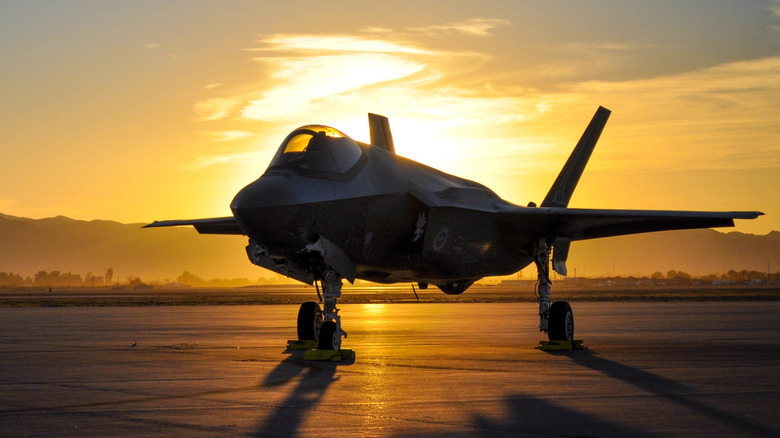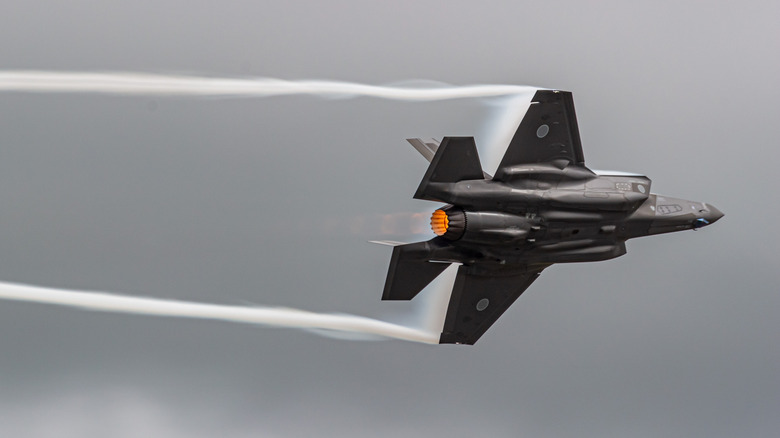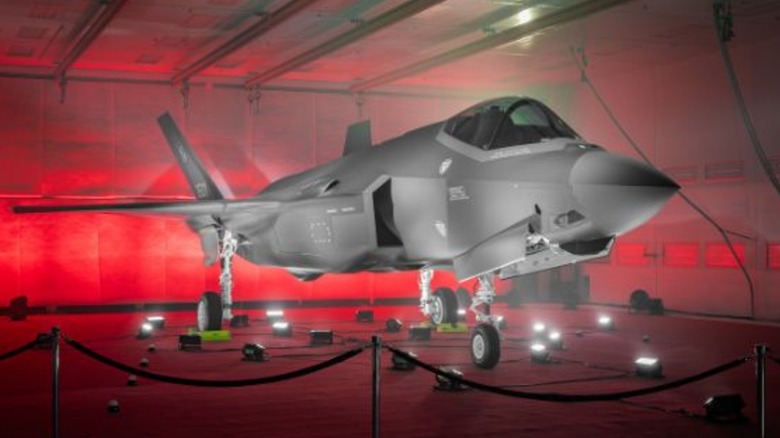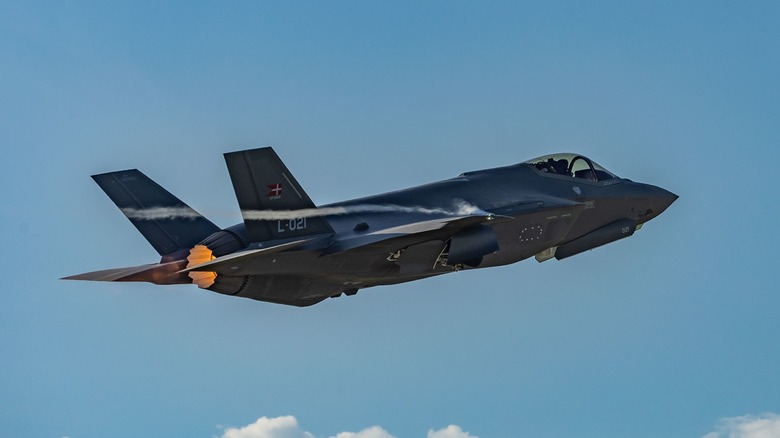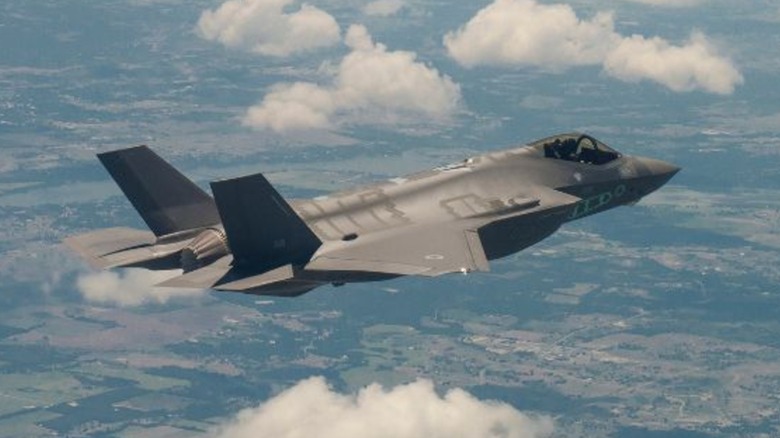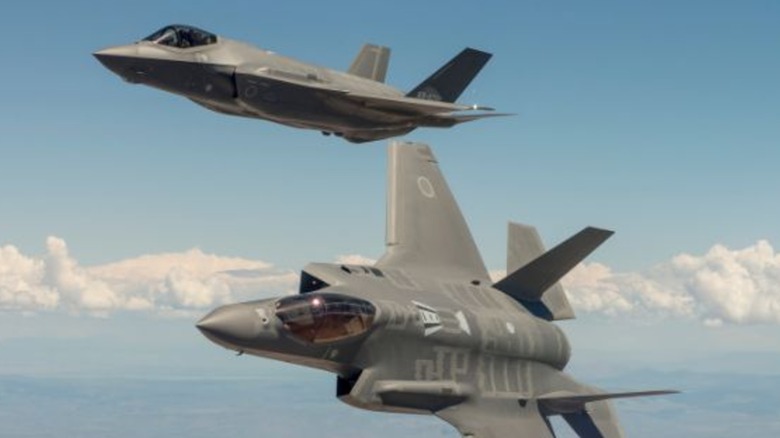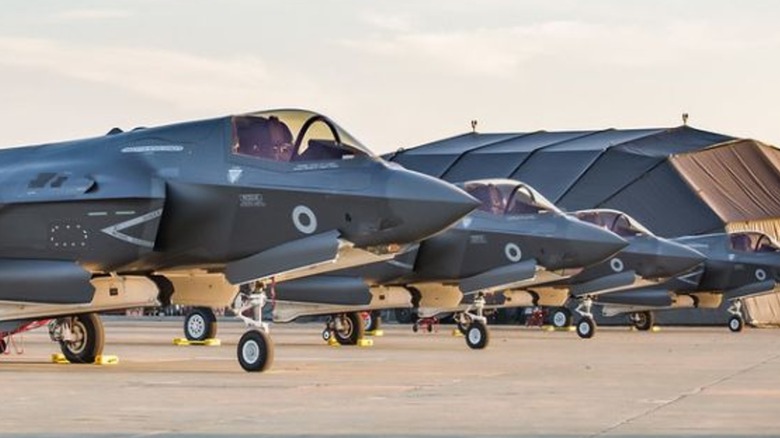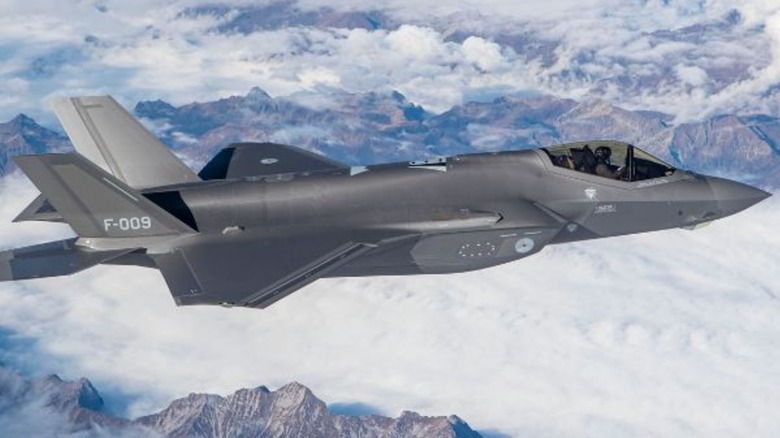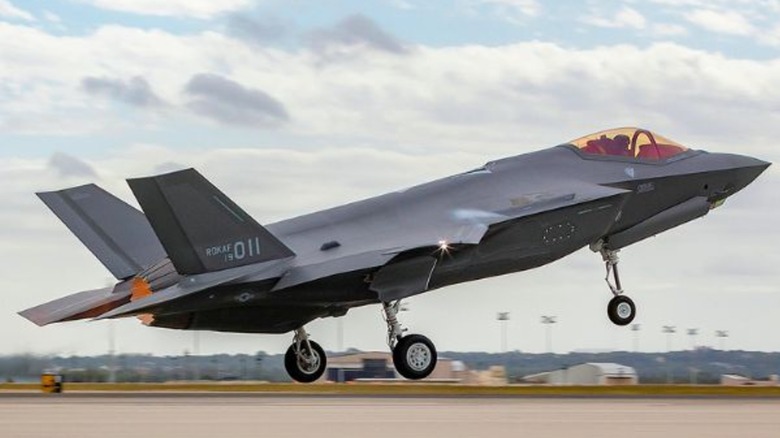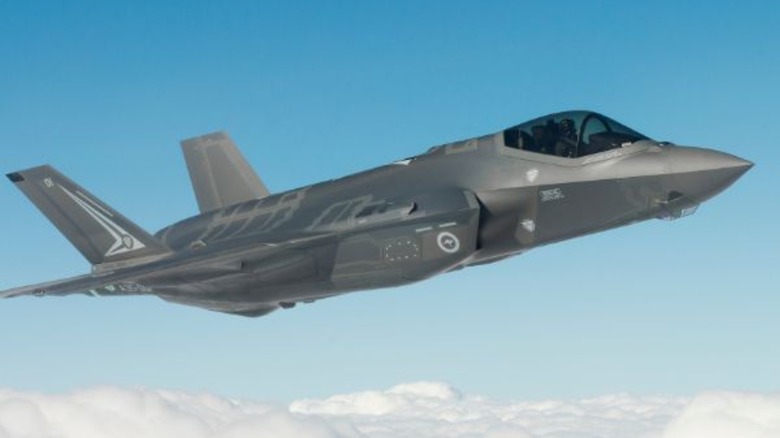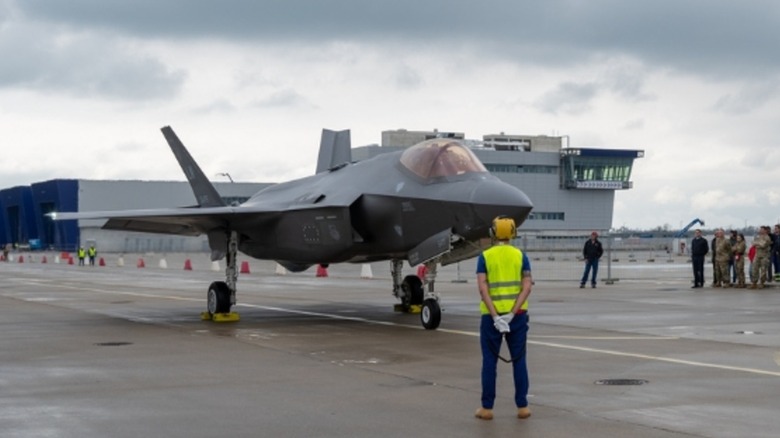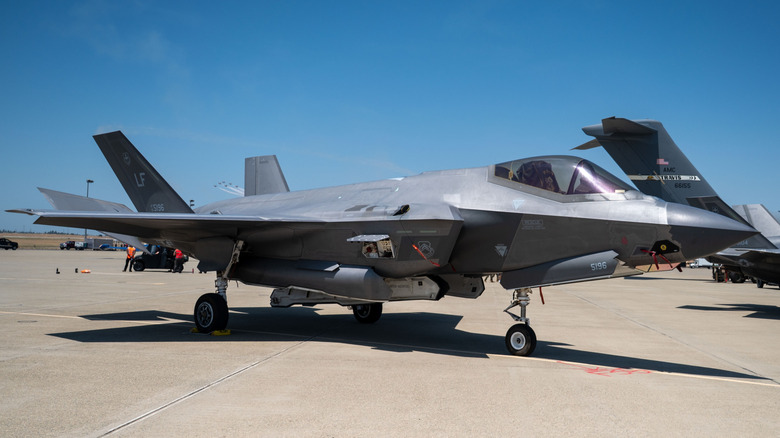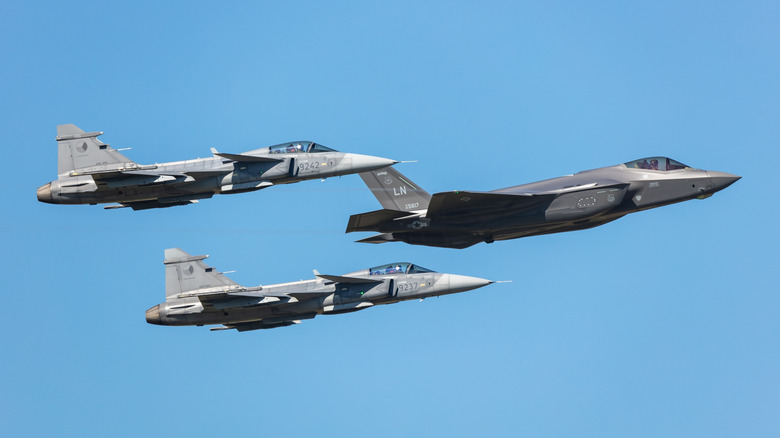Which Countries Fly The F-35 And How Many Do They Have In Their Air Fleet?
No man (or person) is an island. What does this phrase mean? It means nobody is or can be self-sufficient; everyone relies on someone else for something. The same is true for countries — no nation is an island. Well, there are literal island nations such as Japan, Indonesia, and Madagascar, but they still rely on other countries for one reason or another, especially when it comes to national defense.
While many countries build their own arsenals of weapons and vehicles, governments also tend to purchase defense products from other countries, especially when certain items prove superior to locally sourced alternatives. One of the latest weapons to enter the global market is the Lockheed Martin F-35 Lightning II. The manufacturer runs a special program where countries can purchase a set number of F-35s and bolster their existing cache of fighter jets and other military planes. So far, 19 nations have signed up to be part of the F-35 family, and Lockheed Martin is hard at work fulfilling these orders. Good things come to those who wait, and once all these orders are completed, these nations will have some truly special jets.
What's So Special About the F-35
The United States military has an enormous budget. According to the Peter G. Peterson Foundation, the U.S. spends more on its armed forces than China, Russia, Germany, and India combined. Since these countries are a little more discretionary with their discretionary spending, why would they purchase planes as expensive as an F-35?
Well, even though the F-35 officially debuted in 2015, the plane is one of the most advanced fighter jets on the planet. The F-35 can reach speeds of up to Mach 1.6 (approximately 1,200 mph), and it also has stealth capabilities and advanced radar and targeting systems. Moreover, the F-35 can fulfill a wide range of battlefield and defense roles, including combat, reconnaissance, and surveillance.
Before we continue, we should provide an important bit of context – Lockheed Martin produces three different varieties of the F-35. These are the F-35A, F-35B, and F-35C. The F-35A is your standard conventional fighter jet, which requires long runways for takeoffs and landings. The F-35B, meanwhile, is touted as "the first-ever supersonic stealth aircraft with short takeoff/vertical landing capability." Finally, the F-35C boasts larger wings and a bigger fuel tank to carry out "aircraft carrier operations." While all F-35 jets are expensive, the F-35A is the least pricey to maintain and manufacture, so it is the most common variant.
Belgium and Poland
F-35 planes take a long time to build. Depending on when a country's government orders the jets, they might have only recently started receiving completed vehicles. Belgium and Poland are new additions to the F-35 family. The governments of both countries entered in 2018, with Belgium doing so specifically to replace its contingent of F-16s. Production began in 2022 for Belgium and in 2023 for Poland. When the order is complete, these countries will own 34 and 32 F-35As, respectively.
Despite ordering a decent number of planes, both countries "own" one or two at most, but they haven't actually received any. Belgium's first F-35A Lightning II was shipped to Luke Air Force Base on December 3, 2024, and Poland's first two F-35s arrived at Ebbing Air National Guard Base sometime in "late 2024." These planes have yet to touch Belgian or Polish soil. In fact, Belgian officials don't expect to physically receive their first plane until the fall of 2025.
Lockheed Martin was supposed to deliver Belgium's F-35A in late 2023, but production delays pushed the date back significantly. These setbacks also impacted Poland's plans, as their first F-35s were planned to ship in 2024. The current aim is to ship F-35s in batches, but on the bright side, training has already begun. Pilots will hit the ground running when the F-35s finally touch down in their respective countries.
Denmark
One huge reason to order military vehicles from other countries is that your nation isn't, well, big. Even if a nation has a strong manufacturing economy, it might not have enough space to mass-produce advanced warplanes. In 2016, Denmark chose the F-35 as their military's latest fighter jet, and one year later, the country's Parliament approved an F-35 appropriations bill.
Denmark's government put in an order for 27 F-35As. This was only the latest partnership between Denmark and Lockheed Martin, as the nation's military has contracted Lockheed Martin for planes since the 1950s. Some of Denmark's more noteworthy purchases included the T-33 Shooting Star, the F-104 Starfighter, and the F-16 Fighting Falcon.
Lockheed Martin "delivered" the first F-35A in 2021, but the plane didn't arrive in Denmark until 2023, and subsequent deliveries were slow going. As of May 2025, Denmark owns less than half of its ordered fleet, totaling just 15 F-35s. Currently, six Lightning IIs are stationed in Luke Air Force Base for testing. According to Denmark's Defense Ministry, Lockheed Martin won't deliver all the F-35s owed until 2026. Apparently Lockheed Martin ran into issues installing the "Technology Refresh 3 upgrade," which upgrades the plane's computer core. Since every feature in the F-35A relies on this CPU, even the smallest issue could ground the plane, so Lockheed Martin can't afford any mistakes.
Israel
Israel and the United States have a close relationship, especially when it comes to military technology. The U.S. sells countless weapons and vehicles to Israel, and most, if not all, of Israel's fighter jet roster consists of U.S.-built planes. The F-35 is only the latest in this trend.
Israel was Lockheed Martin's first F-35 customer. The country selected the plane way back in 2010. Six years later, the country received its first two F-35As, and in 2017, Israel's F-35s were declared ready for combat. Unlike other customers, Israeli forces were allowed to modify their F-35s with proprietary electronic warfare equipment.
While Lockheed Martin has not released official numbers regarding Israel's order size, as of 2023, the Israeli air force officially owns 39 F-35 jets. However, due to recent events, that might no longer be the case. In mid-June of 2025, Iranian forces claimed to have shot down three F-35s, and that number increased to five a few days later. However, the Israeli government was quick to call these claims "fake news." This game of "he said, she said" makes it difficult to calculate just how many F-35s are currently active in Israel.
Japan
Japan is no slouch in the field of manufacturing fighter jets. Even when the country's production plants don't build new military planes, they at least improve on existing blueprints. For instance, the Mitsubishi F-2 is based on the F-16 Fighting Falcon. The Japanese military's relationship with the F-35 doesn't stray far from that established practice.
Unlike other countries we've discussed so far, Japan didn't request just F-35As. In 2011, the country's Ministry of Defense selected the F-35A as the Japanese Self-Defense Force's (JSDF) primary fighter jet. That order eventually expanded to include F-35Bs. While Japan's F-35Bs are manufactured at the Lockheed Martin Aeronautics production facility in Fort Worth, Texas, Japan's F-35As are pieced together in a "Final Assembly and Check-Out" (FACO) facility situated in Nagoya, Japan. This building is one of three dedicated to assembling all F-35As.
Japan's planned F-35 fleet consists of 105 F-35As and 42 F-35Bs. According to Flight Global's latest report, as of 2025, Japan has only received 38 F-35 fighter jets (the document doesn't differentiate between the F-35As and F-35Bs). Ironically, while the rollout of the F-35 has been delayed in several countries, similar issues have cropped up in the production of other planes the JSDF purchased from different countries. As a result, Japan's military is considering either upgrading older jets or purchasing even more F-35s. Only time will tell if Japan decides to put all its eggs in the F-35 basket.
United Kingdom
So far, most countries we have mentioned ordered either only F-35As or a mix of F-35As and F-35Bs. However, not only did the United Kingdom decide to order just VTOL F-35s, it ordered more than most other countries.
In 2012, Lockheed Martin "delivered" the first F-35Bs to the UK, and in 2014, UK pilots finally mastered the art of the vertical landing. However, these F-35Bs didn't arrive at their permanent home of Royal Air Force Marham (RAF Marham). And like other customers, the UK has been slow to receive new batches of fighter jets.
Back in October 2024, the UK government expected to own 37 F-35Bs — half of what it originally ordered. Fast forward to May 8, 2025, and RAF Marham received two more F-35Bs for a grand sum of 39. The UK government expects the number of its active F-35Bs to increase soon and total 48, but that amount is only part of the country's "first procurement phase," back when the UK military thought it was receiving 74 planes. That number has since jumped to 138, so who knows how long Lockheed Martin will take to finish the UK's order? And that's not even accounting for the possibility that the Royal Air Force will purchase even more F-35Bs (or other F-35 variants) in the near future.
Netherlands
While F-35s were initially produced for the United States military (more on that later), their production and maintenance is a multinational feat. Without certain countries, F-35 production wouldn't exist. Of course, the governments of these nations would order their own fleets.
The Netherlands is a crucial part of the F-35 program. The country ordered 57 F-35A planes, although some news outlets claim the Netherlands actually ordered 52 but quickly added six more for a total of 58. While the planes are primarily assembled in Lockheed Martin facilities, according to Ruben Brekelmans, the Dutch Minister of Defense, the Netherlands produces several "essential parts." Without even one of these components — or the parts other countries manufacture — F-35 production would come to a standstill.
As of September 2024, the Netherlands has received 40 of the requested planes. While the Netherlands remains committed to the global F-35 fighter jet program, some country officials are concerned whether the same can be said of the United States. The Netherlands might manufacture several crucial components, but the U.S. supplies all beyond line-of-sight communications, ammunition, and targeting capacities. Fears that the U.S. will magically turn off the Dutch F-35 fleet via a "kill switch" are fairly prominent, especially because of the nature of the current administration (their words, not ours).
Republic of Korea
The Republic of Korea is in a unique and unenviable position because its neighbor to the north would love nothing more than to conquer the country, as well as the rest of the world. However, many of North Korea's armaments, including their tanks, are little more than "flashy garbage." Still, better stealthy than sorry.
In 2014, the Republic of Korea Air Force (ROKAF) ordered F-35A planes. The country's military wanted to replace its retinue of F-4 Phantom II and F-5 fighter jets, and to that end, it purchased 40 F-35As. The first plane wasn't delivered until 2019, but subsequent shipments arrived with surprisingly steady regularity.
As of 2022, ROKAF has 40 fully functioning F-35A stealth jets. For a time, the country had no outstanding orders, but in 2023, ROKAF put in a request for 20 additional F-35A jets. That is not-so-possibly-coincidentally the same number of F-35 jets the South Korean Large Transport Vessel-II project was supposed to hold. Perhaps the South Korean government placed the order just for this vessel? However, in May 2025, the project changed gears to focus on storing unmanned drones in the ship. If the second order of F-35 jets was indeed purchased for the Large Transport Vessel-II, this ship's repurposing might leave the purchase order up in the air.
Norway
To the public eye, there is little rhyme or reason to how Lockheed Martin fulfills F-35 orders. The Netherlands was the company's second foreign Lightning II customer, yet Lockheed Martin still hasn't completed the country's order. Meanwhile, Lockheed Martin has sent all the planes it promised to Norway.
According to Lockheed Martin, the company has been supporting the Royal Norwegian Air Force (RNoAF) for "more than 50 years" and has supplied countless planes, including the F-16 and the Cold War-era P-3 Orion surveillance plane. In 2008, the RNoAF ordered 52 F-35A jets, the first of which finally took flight in 2015 and arrived on Norwegian soil in 2017.
As we previously stated, the Republic of Korea finished its original commitment of 40 F-35As in 2022, and a year later, the military decided to order 20 more, thus changing its order status to "incomplete." The same cannot be said of Norway. On April 1, 2025, RNoAF announced that it had finally received all 52 F-35A planes, making it the first "partner nation" to have its order completed– even though Lockheed Martin technically fulfilled the Republic of Korea's request for 40 F-35As in 2022 before the country ordered more. Regardless, not only will Norway's F-35s help protect the country, but RNoAF will also use them to fulfil NATO-related responsibilities.
Australia
As previously stated, the F-35 program is a multinational effort. Australia lends a huge hand, and not just because its government ordered an armada of fighter jets.
Australia is another country whose government changed its mind on how many F-35s it wanted. Originally, the Royal Australian Air Force (RAAF) ordered 72 F-35A stealth jets, the first two of which were delivered in December 2018. In December 2024, Australia received the final nine F-35As of the original order. More importantly, these penultimate planes shipped with the Technology Refresh 3 upgrade, which might explain why RAAF subsequently increased its requested fighter jets to 100.
Lockheed Martin has partnered with RAAF and over 70 Australian companies to become the "industry leader of Original Equipment Manufacture in Australia." Through this collaboration, both organizations support the production of fighter jets in the country and have allegedly created thousands of Australian jobs. These collaborating companies are an integral part of the global F-35 supply chain; without them, every country in the F-35 program would suffer from an interruption in plane deployment and maintenance.
Italy
As we already established, F-35s are expensive, not just to buy but also to maintain. The more a country's government is willing to spend, the more it can purchase. And if they find enough extra cash behind the sofa cushions, they can buy even more.
Italy is the second country to order a mix of F-35As and F-35Bs. Moreover, the nation participates in production duties thanks to a manufacturing plant in Cameri. Initially, Italy ordered 60 F-35As and 30 F-35Bs. The first Italian-produced F-35 took flight in 2015, and a year later, the stealth jet made its home at the Amendola Air Base.
As of September 2024, the Italian Air Force ordered 15 more F-35As and 10 extra F-35Bs, bringing the total requested planes to 115. More importantly, Lockheed Martin and the local Italian manufacturing plants had fulfilled the initial order and supplied the Italian Air Force with 90 F-35s the very same year. The supplementary F-35 purchases can be traced to an increase in Italy's defense budget. 7.5 billion euros were set aside for this order, although some sources claim the amount was only 7 billion euros. If Italy's defense spending increases even more next year, the country could purchase yet another series of F-35s.
United States
Since the F-35 Lightning IIs were initially developed for the United States, the U.S. government gets priority ownership of these planes. And let's not forget that since the U.S. spends more on its military than any other country on the planet, it can afford to have larger F-35 fleets.
The United States military selected the F-35 as far back as 2011, and each branch that put in a request (Air Force, Marines, and Navy) started receiving their first stealth jets in the subsequent years. Moreover, the different services put in vastly different orders. The Air Force went all in on F-35As with a whopping 1,763 units, whereas the Marine Corps split the purchase between 353 F-35Bs and 67 F-35Cs. And finally, the Navy signed up for 273 F-35Cs. So far, the United States is the only country to request any F-35Cs.
In total, the United States military has 1,707 F-35s in total, making it one of the most common fighter jets in U.S. military hangars. While we don't have exact numbers, over 500 of these planes are F-35As, and around 100 are F-35Cs. These numbers are only going to grow.
Countries With Plans to Obtain F-35s
Building an F-35 takes time. Many countries that recently placed orders are still waiting for theirs. However, some nations are going back and forth on whether they still want the planes.
Let's start with the countries that ordered F-35s but are still waiting for delivery. All are recent additions to Lockheed Martin's F-35 Global Enterprise program. These countries have yet to receive any jets. For instance, Canada ordered 88 F-35As back in 2023; the Czech Republic requested 24 F-35As in 2024, and Finland purchased 64 F-35As in 2021. We don't even know how many Romania ordered, and of these recent recruits, only the Republic of Singapore purchased multiple types of jets — eight F-35As and 12 F-35Bs.
While Lockheed Martin is presumably working towards fulfilling these orders, whether the countries will receive them — or still want them — is another matter. Canada is a prime example, as in March of 2025, the country's government started to "review" its procurement plans. Fears of a potential "kill switch" that could ground the planes, coupled with Trump's public desire to annex Canada, convinced the Canadian Air Force to reconsider whether it still wanted F-35s. Switzerland's military (which ordered 36 F-35As) is also mulling over whether it should renege on its purchase and seek European alternatives, once again citing Trump's behavior. Who knows what the future holds in store for Lockheed Martin and its global F-35 program?
